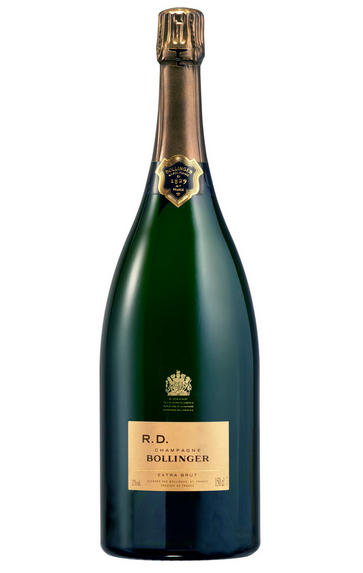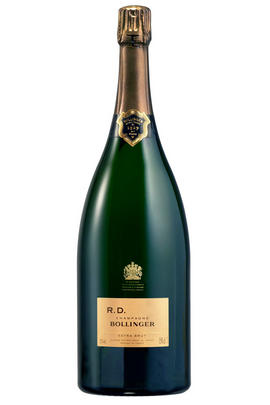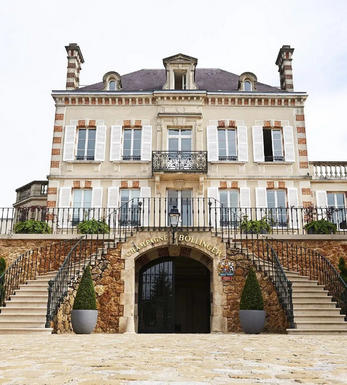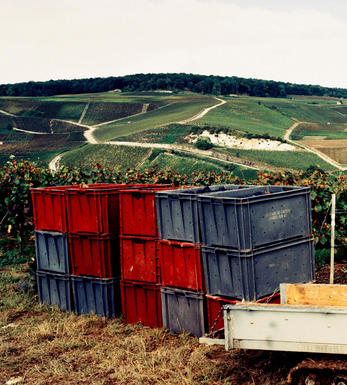
2007 Champagne Bollinger, RD, Extra Brut (Disgorged 10/07/2020)

Critics reviews
Bollinger’s 2007 R.D. is superb, but it is also a wine that reflects the nature of a unique and challenging growing season. In most vintages the R.D. is marked by the distinct creaminess and breadth of Aÿ Pinot Noir. Two thousand seven, though, was a difficult year marked by very dry weather, rain at the end of the growing season and an early harvest in August, something that was not as common as it has become. Selection was essential.
For the 2007, the blend is composed of just 14 villages compared to the more typical 18-25. Verzenay is the main Pinot component while Cramant plays the leading role in the Chardonnays. For these reasons, the 2007 is an R.D. driven by more focus, energy and tension than readers are used to seeing. Lemon confit, dried flowers, sage, mint, crushed rocks, almond and ginger are some of the aromas and flavors that give the 2007 its complex, multi-faceted personality. The 2007 can be enjoyed now, but I would prefer to cellar it for a few years.
It will age effortlessly for decades as it moves through the various phases of its life. I was reminded of the way Champagne can magically traverse time by magical bottles of the 1976 R.D. and 1996 Vieilles Vignes Françaises I tasted recently.
Antonio Galloni, Vinous.com
What an amazing nose this has, like the smell of a rock pool on a rocky coast, but with so many candied-fruit, spicy and mushroom notes behind that. That fruit is way more expressive on the powerful and structured palate with lime freshness and chalky minerality at the super-long, bone-dry finish. Disgorged 28th May 2021.
James Suckling, jamessuckling.com
About this WINE

Bollinger
The Champagne House of Bollinger was established in 1829 by Jacques Bollinger and Paul Renaudin. Over the years the vineyard holdings have been steadily increased with the largest expansion taking place under the stewardship of the legendary Mme Lily Bollinger. She ran the company between 1941 and 1977 and today it is managed by her great-nephew, Ghislain de Montgolfier.
Bollinger has a reputation for producing muscular champagnes with body, depth and power, and is today considered one of the "Great" Champagne houses.
70% of the grapes come from the firm's own vineyards. 80% of the harvest is barrel-fermented with the wines being kept on their yeast lees for an extended period of time (in the case of the RD, around 10 years).
Bollinger produces classic, complex, Pinot-Noir dominated champagnes with the ability to age gracefully for many years.

Recently Disgorged
The Recently Disgorged (RD) Champagne style was introduced for the first time by Madame Bollinger in 1961, on the 1952 Bollinger La Grande Année vintage. Disgorgement (or dégorgement) is a core process in the traditional method of sparkling wine-making. It involves the removal of the frozen sediment (yeast) collected in a plastic pot (pellet) at the neck of the inverted bottle, at the conclusion of the Champagne's ageing process after the second fermentation.
In instances where disgorgement is deliberately delayed to the point just prior to the release of the bottling to the market, the Champagne benefits from a prolonged maturation on its lees (yeast), which reinforces the aromatic subtlety and complexity of the final wine. Most importantly, late disgorgement allows the Champagne to retain its freshness, vivacity and fruity expression despite the ageing.
Recommended Producers: Bollinger RD the most famous and exquisite exponent of the style, Pol Roger.

Champagne blend
Which grapes are included in the blend, and their proportion, is one of the key factors determining the style of most Champagnes. Three grapes are used - Pinot Noir, Chardonnay and Pinot Meunier.
26% of vineyards in Champagne are planted with Chardonnay and it performs best on the Côtes des Blancs and on the chalk slopes south of Epernay. It is relatively simple to grow, although it buds early and thus is susceptible to spring frosts. It produces lighter, fresher wines than those from Burgundy and gives finesse, fruit and elegance to the final blend. It is the sole grape in Blancs de Blancs, which are some of the richest long-lived Champagnes produced.
Pinot Noir accounts for nearly 40% of the plantings in Champagne and lies at the heart of most blends - it gives Champagne its body, structure, strength and grip. It is planted across Champagne and particularly so in the southern Aube district.
The final component is Pinot Meunier and this constitutes nearly 35% of the plantings. Its durability and resistance to spring frosts make the Marne Valley, a notorious frost pocket, its natural home. It ripens well in poor years and produces a soft, fruity style of wine that is ideal for blending with the more assertive flavours of Pinot Noir. Producers allege that Pinot Meunier lacks ageing potential, but this does not deter Krug from including around 15% of it in their final blends.


Buying options
Add to wishlist
Description
Bollinger’s 2007 R.D. is superb, but it is also a wine that reflects the nature of a unique and challenging growing season. In most vintages the R.D. is marked by the distinct creaminess and breadth of Aÿ Pinot Noir. Two thousand seven, though, was a difficult year marked by very dry weather, rain at the end of the growing season and an early harvest in August, something that was not as common as it has become. Selection was essential.
For the 2007, the blend is composed of just 14 villages compared to the more typical 18-25. Verzenay is the main Pinot component while Cramant plays the leading role in the Chardonnays. For these reasons, the 2007 is an R.D. driven by more focus, energy and tension than readers are used to seeing. Lemon confit, dried flowers, sage, mint, crushed rocks, almond and ginger are some of the aromas and flavors that give the 2007 its complex, multi-faceted personality. The 2007 can be enjoyed now, but I would prefer to cellar it for a few years.
It will age effortlessly for decades as it moves through the various phases of its life. I was reminded of the way Champagne can magically traverse time by magical bottles of the 1976 R.D. and 1996 Vieilles Vignes Françaises I tasted recently.
Antonio Galloni, Vinous.com
wine at a glance
Delivery and quality guarantee